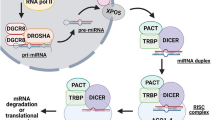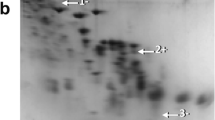Abstract
We hypothesized that protein turnover would be substantially suppressed during estivation in the land snail, Otala lactea, as part of a wholesale move to conserve ATP in the hypometabolic state, and that decreased rates of protein synthesis and degradation would be mediated by altering the phosphorylation state of key proteins. Rates of protein translation, measured in vitro, decreased by ~80% in extracts of foot muscle and hepatopancreas after 2 days of estivation, and this reduction was associated with strong increases in the phosphorylation of ribosomal factors, eIF2α and eEF2, as well as decreased phosphorylation of 4E-BP1. Reductions in levels of markers of ribosomal biogenesis and a tissue-specific reduction in the phosphorylation state of eIF4E and eIF4GI were also evident after 14 days of estivation. Activity of the 20S proteasome decreased by 60–80% after 2 days of estivation and this decrease was mediated by protein kinase G in vitro, whereas protein phosphatase 2A activated the proteasome. Levels of protein carbonyls did not change in snail tissues during estivation whereas the expression heat shock proteins increased, suggesting that protein resistance to damage is enhanced in estivation. In conclusion, protein synthesis and degradation rates were coordinately suppressed during estivation in O. lactea and this is associated with the phosphorylation of ribosomal initiation and elongation factors and the 20S proteasome.







Similar content being viewed by others
Abbreviations
- eIF:
-
Eukaryotic initiation factor
- eEF:
-
Eukaryotic elongation factor
- P70S6K:
-
70 kDa protein kinase of ribosomal S6 protein
- 4E-BP1:
-
Binding protein-1 of eIF4E
- 20S, MCP:
-
Multicatalytic proteasome
- mTOR:
-
Mammalian target of rapamycin
References
Guppy M, Withers P (1999) Metabolic depression in animals: physiological perspectives and biochemical generalizations. Biol Rev Camb Philos Soc 74(1):1–40. doi:10.1017/S0006323198005258
Barnhart MC, McMahon BR (1988) Depression of aerobic metabolism and intracellular pH by hypercapnia in land snails, Otala lactea. J Exp Biol 138:289–299
Hermes-Lima M, Storey KB (1995) Antioxidant defenses and metabolic depression in a pulmonate land snail. Am J Physiol 268:R1386–R1393
Brooks SPJ, Storey KB (1997) Glycolytic controls in estivation and anoxia: a comparison of metabolic arrest in land and marine molluscs. Comp Biochem Physiol A 18(4):1103–1114. doi:10.1016/S0300-9629(97)00237-5
Hermes-Lima M, Storey JM, Storey KB (1998) Antioxidant defenses and metabolic depression. The hypothesis of preparation for oxidative stress in land snails. Comp Biochem Physiol B 120:437–448. doi:10.1016/S0305-0491(98)10053-6
Bishop T, Brand MD (2000) Processes contributing to metabolic depression in hepatopancreas cells from the snail Helix aspersa. J Exp Biol 203:3603–3612
Pakay JL, Withers PC, Hobbs AA, Guppy M (2002) In vivo downregulation of protein synthesis in the snail Helix aspersa during estivation. Am J Physiol 283(1):R197–R204
Pakay JL, Hobbs AA, Kiball SR, Guppy M (2003) The role of eukaryotic initiation factor 2alpha during the metabolic depression associated with estivation. J Exp Biol 206:2363–2371. doi:10.1242/jeb.00422
Ramos-Vasconcelos GR, Hermes-Lima M (2003) Hypometabolism, antioxidant defenses, and free radical metabolism in the pulmonate land snail Helix aspersa. J Exp Biol 206:675–685. doi:10.1242/jeb.00124
Ramnanan CJ, Storey KB (2006) Glucose-6-phosphate dehydrogenase regulation during hypometabolism. Biochem Biophys Res Commun 339:7–16. doi:10.1016/j.bbrc.2005.10.036
Ramnanan CJ, Storey KB (2006) Suppression of Na+K+-ATPase activity during estivation in the land snail Otala lactea. J Exp Biol 209:677–688. doi:10.1242/jeb.02052
Ramnanan CJ, Groom AG, Storey KB (2007) Akt and its downstream targets play key roles in mediating dormancy in land snails. Comp Biochem Physiol B 148(3):245–255. doi:10.1016/j.cbpb.2007.06.002
Hyman LH (1968) The invertebrates vol VI, Mollusca I. McGraw-Hill, New York, p 792
Buttgereit F, Brand MD (1995) A hierarchy of ATP-consuming processes in mammalian cells. Biochem J 312:163–167
Storey KB, Storey JM (2004) Metabolic rate depression in animals: transcriptional and translational controls. Biol Rev Camb Philos Soc 79(1):207–233. doi:10.1017/S1464793103006195
Hochachka PW, Buck LT, Doll CJ, Land SC (1996) Unifying theory of hypoxia tolerance: molecular/metabolic defense and rescue mechanisms for surviving oxygen lack. Proc Natl Acad Sci USA 93:9493–9498. doi:10.1073/pnas.93.18.9493
Van Breukelen F, Hand SC (2000) Characterization of ATP-dependent proteolysis in embryos of the brine shrimp, Artemia franciscana. J Comp Physiol [B] 170(2):125–133. doi:10.1007/s003600050267
Epperson LE, Dahl TA, Martin SL (2004) Quantitative analysis of liver protein expression during hibernation in the golden-mantled ground squirrel. Mol Cell Proteomics 3(9):920–933. doi:10.1074/mcp.M400042-MCP200
Poortinga G, Hannan KM, Snelling H, Walkley CR, Jenkins A, Sharkey K, Wall M, Brandenburger Y, Palatsides M, Pearson RB, McArthur GA, Hannan RD (2004) MAD1 and c-MYC regulate UBF and rDNA transcription during granulocyte differentiation. EMBO J 23(16):3325–3335. doi:10.1038/sj.emboj.7600335
Surks MI, Berkowitz M (1972) Rat hepatic polysome profiles and in vitro protein synthesis during hypoxia. Am J Physiol 220(6):1606–1609
Frerichs KU, Smith CB, Brenner M, DeGracia DJ, Krause GS, Marrone L, Dever TE, Hallenbeck JM (1998) Suppression of protein synthesis in brain during hibernation involves inhibition of protein initiation and elongation. Proc Natl Acad Sci USA 95(24):14511–14516. doi:10.1073/pnas.95.24.14511
Larade K, Storey KB (2002) Reversible suppression of protein synthesis in concert with polysome disaggregation during anoxia exposure in Littorina littorea. Mol Cell Biochem 232:121–127. doi:10.1023/A:1014811017753
Van Breukelen F, Sonenberg N, Martin SL (2004) Seasonal and state-dependent changes of eIF4E and 4E-BP1 during mammalian hibernation: implications for the control of translation during torpor. Am J Physiol 287:R349–R353
Herbert TP, Kilhams GR, Batty IH, Proud CG (2000) Distinct signalling pathways mediate insulin and phorbol ester-stimulated eukaryotic initiation factor 4F assembly and protein synthesis in HEK 293 cells. J Biol Chem 275(15):11249–11256. doi:10.1074/jbc.275.15.11249
Gingras A, Raught B, Sonnenburg N (2001) Regulation of translation initiation by FRAP/mTOR. Genes Dev 15:807–826. doi:10.1101/gad.887201
Proud CG (2006) Regulation of protein synthesis by insulin. Biochem Soc Trans 34:213–216. doi:10.1042/BST20060213
Oldham S, Hafen E (2003) Insulin/IGF and target of rapamycin signaling: a TOR de force in growth control. Trends Cell Biol 13:79–85. doi:10.1016/S0962-8924(02)00042-9
Scott PH, Brunn GJ, Kohn AD, Roth RA, Lawrence JC (1998) Evidence of insulin-stimulated phosphorylation and activation of the mammalian target of rapamycin mediated by a protein kinase B signaling pathway. Proc Natl Acad Sci USA 95:7772–7777. doi:10.1073/pnas.95.13.7772
Woods AK, Storey KB (2006) Vertebrate freezing survival: regulation of the multicatalytic proteinase complex and controls on protein degradation. Biochim Biophys Acta 1760(3):395–403
Brooks SPJ (1992) A simple computer program with statistical tests for the analysis of enzyme kinetics. Biotechniques 13:906–911
Fuery CJ, Withers PC, Hobbs AA, Guppy M (1998) The role of protein synthesis during metabolic depression in the Australian desert frog Neobatrachus centralis. Comp Biochem Physiol A 119(2):469–476. doi:10.1016/S1095-6433(97)00453-4
Lin CJ, Cencic R, Mills JR, Robert F, Pelletier J (2008) c-Myc and eIF4F are components of a feedforward loop that links transcription and translation. Cancer Res 68(13):5326–5334. doi:10.1158/0008-5472.CAN-07-5876
Proud CG (2007) Signalling to translation: how signal transduction pathways control the protein synthetic machinery. Biochem J 403(2):217–234. doi:10.1042/BJ20070024
Minich WB, Balasta ML, Goss DJ, Rhoads RE (1994) Chromatographic resolution of in vivo phosphorylated and nonphosphorylated eukaryotic translation initiation factor eIF-4E: increased cap affinity of the phosphorylated form. Proc Natl Acad Sci USA 91:7668–7672. doi:10.1073/pnas.91.16.7668
Raught B, Gingras A, Sonnenburg N (2001) The target of rapamycin (TOR) proteins. Proc Natl Acad Sci USA 98:7037–7044. doi:10.1073/pnas.121145898
Orlowski M, Wilk S (2003) Ubiquitin-independent proteolytic functions of the proteasome. Arch Biochem Biophys 415:1–5. doi:10.1016/S0003-9861(03)00197-8
Pereira ME, Wilk S (1990) Phosphorylation of the multi-catalytic proteinase complex from bovine pituitaries by a copurifying cAMP-dependent protein kinase. Arch Biochem Biophys 283:68–74. doi:10.1016/0003-9861(90)90613-4
Hudson NJ, Lehnert SA, Ingham AB, Symonds B, Franklin CE, Harper GS (2005) Lessons from an estivating frog: sparing muscle protein despite starvation and disuse. Am J Physiol 290(3):R836–R843
Ramaglia V, Buck LT (2004) Time-dependent expression of heat shock proteins 70 and 90 in tissues of the anoxic western painted turtle. J Exp Biol 207(21):3775–3784. doi:10.1242/jeb.01211
Reuner A, Brümmer F, Schill RO (2008) Heat shock proteins (Hsp70) and water content in the estivating Mediterranean grunt snail (Cantareus apertus). Comp Biochem Physiol B 151(1):28–31. doi:10.1016/j.cbpb.2008.05.004
Ivanina AV, Habinck E, Sokolova IM (2008) Oxidative stress and expression of chaperones in aging mollusks. Comp Biochem Physiol B 150(1):53–61. doi:10.1016/j.cbpb.2008.01.005
Acknowledgments
Thanks to J. M. Storey for editorial comment on the manuscript. The research was supported by a discovery grant from the Natural Sciences and Engineering Research Council of Canada (OPG 6793) to K.B.S., by an NSERC postgraduate scholarship to C.J.R. and by NSERC USRA scholarships to MEA and AGG.
Author information
Authors and Affiliations
Corresponding author
Rights and permissions
About this article
Cite this article
Ramnanan, C.J., Allan, M.E., Groom, A.G. et al. Regulation of global protein translation and protein degradation in aerobic dormancy. Mol Cell Biochem 323, 9–20 (2009). https://doi.org/10.1007/s11010-008-9959-2
Received:
Accepted:
Published:
Issue Date:
DOI: https://doi.org/10.1007/s11010-008-9959-2




